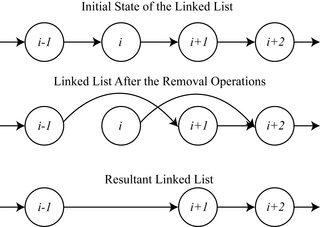Related Research Articles
A real-time operating system (RTOS) is an operating system (OS) for real-time computing applications that processes data and events that have critically defined time constraints. An RTOS is distinct from a time-sharing operating system, such as Unix, which manages the sharing of system resources with a scheduler, data buffers, or fixed task prioritization in multitasking or multiprogramming environments. All operations must verifiably complete within given time and resource constraints or else fail safe. Real-time operating systems are event-driven and preemptive, meaning the OS can monitor the relevant priority of competing tasks, and make changes to the task priority. Event-driven systems switch between tasks based on their priorities, while time-sharing systems switch the task based on clock interrupts.

In computer science, mutual exclusion is a property of concurrency control, which is instituted for the purpose of preventing race conditions. It is the requirement that one thread of execution never enters a critical section while a concurrent thread of execution is already accessing said critical section, which refers to an interval of time during which a thread of execution accesses a shared resource or shared memory.

Non-uniform memory access (NUMA) is a computer memory design used in multiprocessing, where the memory access time depends on the memory location relative to the processor. Under NUMA, a processor can access its own local memory faster than non-local memory. NUMA is beneficial for workloads with high memory locality of reference and low lock contention, because a processor may operate on a subset of memory mostly or entirely within its own cache node, reducing traffic on the memory bus.

In computer science, a thread of execution is the smallest sequence of programmed instructions that can be managed independently by a scheduler, which is typically a part of the operating system. In many cases, a thread is a component of a process.

Memory management is a form of resource management applied to computer memory. The essential requirement of memory management is to provide ways to dynamically allocate portions of memory to programs at their request, and free it for reuse when no longer needed. This is critical to any advanced computer system where more than a single process might be underway at any time.

In concurrent computing, deadlock is any situation in which no member of some group of entities can proceed because each waits for another member, including itself, to take action, such as sending a message or, more commonly, releasing a lock. Deadlocks are a common problem in multiprocessing systems, parallel computing, and distributed systems, because in these contexts systems often use software or hardware locks to arbitrate shared resources and implement process synchronization.

Parallel computing is a type of computation in which many calculations or processes are carried out simultaneously. Large problems can often be divided into smaller ones, which can then be solved at the same time. There are several different forms of parallel computing: bit-level, instruction-level, data, and task parallelism. Parallelism has long been employed in high-performance computing, but has gained broader interest due to the physical constraints preventing frequency scaling. As power consumption by computers has become a concern in recent years, parallel computing has become the dominant paradigm in computer architecture, mainly in the form of multi-core processors.

In computer science, inter-process communication (IPC), also spelled interprocess communication, are the mechanisms provided by an operating system for processes to manage shared data. Typically, applications can use IPC, categorized as clients and servers, where the client requests data and the server responds to client requests. Many applications are both clients and servers, as commonly seen in distributed computing.
In computer science, a semaphore is a variable or abstract data type used to control access to a common resource by multiple threads and avoid critical section problems in a concurrent system such as a multitasking operating system. Semaphores are a type of synchronization primitive. A trivial semaphore is a plain variable that is changed depending on programmer-defined conditions.
In computing, scheduling is the action of assigning resources to perform tasks. The resources may be processors, network links or expansion cards. The tasks may be threads, processes or data flows.
In computer science, a lock or mutex is a synchronization primitive that prevents state from being modified or accessed by multiple threads of execution at once. Locks enforce mutual exclusion concurrency control policies, and with a variety of possible methods there exist multiple unique implementations for different applications.
In computer science, resource starvation is a problem encountered in concurrent computing where a process is perpetually denied necessary resources to process its work. Starvation may be caused by errors in a scheduling or mutual exclusion algorithm, but can also be caused by resource leaks, and can be intentionally caused via a denial-of-service attack such as a fork bomb.
In concurrent programming, concurrent accesses to shared resources can lead to unexpected or erroneous behavior. Thus, the parts of the program where the shared resource is accessed need to be protected in ways that avoid the concurrent access. One way to do so is known as a critical section or critical region. This protected section cannot be entered by more than one process or thread at a time; others are suspended until the first leaves the critical section. Typically, the critical section accesses a shared resource, such as a data structure, peripheral device, or network connection, that would not operate correctly in the context of multiple concurrent accesses.
In computer science, thrashing occurs in a system with virtual memory when a computer's real storage resources are overcommitted, leading to a constant state of paging and page faults, slowing most application-level processing. This causes the performance of the computer to degrade or even collapse. The situation can continue indefinitely until the user closes some running applications or the active processes free up additional virtual memory resources.
In computing, a system resource, or simply resource, is any physical or virtual component of limited availability that is accessible to a computer. All connected devices and internal system components are resources. Virtual system resources include files, network connections, and memory areas.
Concurrent computing is a form of computing in which several computations are executed concurrently—during overlapping time periods—instead of sequentially—with one completing before the next starts.
In computer science, synchronization is the task of coordinating multiple processes to join up or handshake at a certain point, in order to reach an agreement or commit to a certain sequence of action.
Scratchpad memory (SPM), also known as scratchpad, scratchpad RAM or local store in computer terminology, is an internal memory, usually high-speed, used for temporary storage of calculations, data, and other work in progress. In reference to a microprocessor, scratchpad refers to a special high-speed memory used to hold small items of data for rapid retrieval. It is similar to the usage and size of a scratchpad in life: a pad of paper for preliminary notes or sketches or writings, etc. When the scratchpad is a hidden portion of the main memory then it is sometimes referred to as bump storage.

The Slurm Workload Manager, formerly known as Simple Linux Utility for Resource Management (SLURM), or simply Slurm, is a free and open-source job scheduler for Linux and Unix-like kernels, used by many of the world's supercomputers and computer clusters.
This page is a glossary of Operating systems terminology.
References
- ↑ Knauerhase, Rob (2008). "Using OS Observations to Improve Performance in Multicore Systems". IEEE Micro. 28 (3): 54–66. doi:10.1109/mm.2008.48. S2CID 9202433.
- ↑ Zhang, Xiao (2009). "Towards practical page coloring-based multicore cache management". Proceedings of the 4th ACM European conference on Computer systems. pp. 89–102. doi:10.1145/1519065.1519076. ISBN 9781605584829. S2CID 5769992.